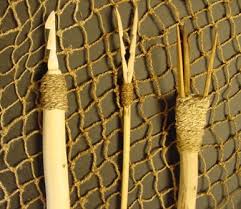You can also strike fish with a spear, arrow and (cross) bow or a harpoon (spear barbed at the point).
 If you put a straight stick diagonally in the water it seems like he makes a bend below the surface. Light has a different refractive index in water than in air. You do not see from above the water exactly where things are located underwater. Try to hit something with your stick and you understand how much you need to correct, depending on the depth.
If you put a straight stick diagonally in the water it seems like he makes a bend below the surface. Light has a different refractive index in water than in air. You do not see from above the water exactly where things are located underwater. Try to hit something with your stick and you understand how much you need to correct, depending on the depth.
So you have to be either very proficient, or very lucky to get a fish.
Therefore, a fishing spear usually has more points. (Such as the tridentof Neptune.) Cleave the top of a thick spear in star shape to about 20 cm deep. Spread the bars by adding sprigs between them. Point each bar (and cut a hook or barb). Stabbing works, throwing mostly not.
If you can hunt under water (with a mask) you do not suffer from the distortion caused by light refraction. Your catch will look a lot (about 1/3rd) smaller on surface.
Another possibility is to make sure that you are right above the prey (wade, boat) you want to impale. Then you don’t see any distortion.
Tip for spearfishing: before you shoot or throw a harpoon, put a rope on it...
(Because spearfishing is about short distances a few meters rope is sufficient, with a float at the end. An pricking is more effective than throwing. Many camouflaged fish are so confident that they are invisible, and just keep lying motionless, even when you are nearby.)
Alternative fishing techniques
A film on the internet shows a homeless wading through a single deep LA river and throwing child head-thick stones to the fish. After a minute he has a big carp 'hooked'.
Ernest Claes says (in The Old Clock) "At a distance of several meters are made, with the weeds from the creek and turf, two small dikes, that protrude just above the water, they let the water seep through, but not the fish. Once these are ready we start "meuren" (‘muddy’ing”?) the water between the dams by dredging and retrieve the ground corpse with the feet, until it becomes so dark dirt that fish were stabbing theirhead upwards to gasp some air. With hands or with the cap one catches them easily. "(But mostly involved a meager catch of aquatic animals and very little fish.)
European Flounder (Platichthys flesus) is a flatfish (50 cm) with a row clearly palpable nodules behind the head and along the sidelines and excellent camouflage colors, akin to the plaice, which occurs in coastal waters and rivers. He has irregular spots. (Plaice is completely smooth, the skin of the feels rough when you rub from tail to head.) He even is outwited by stepping on it.
In Cambodian (Putsor village) in shallow water and on shore fish is caught by placing a funnel made of woven twigs as a mini-nets quickly over a fish. (Khmer fishing). It is so successful that they even dammed rivers in the dry season, or empty ponds to capture mainly catfish with nets and baskets, or poke them with sticks and hands, landing net or covering cloth out of the mud.
Flounder can be catched with bare feet in 30 cm deep water. If you feel you stand on a Flounder you pick the fish by its tail out of the water.
Saponines (from soapwort, chestnut ..) can stun and even kill fish.
(See also <Eel babbing> and <Nets>.)
Colleague, when a fisherman after two hours of waiting moves a foot:”Hey, are you here to fish or to dance?"
